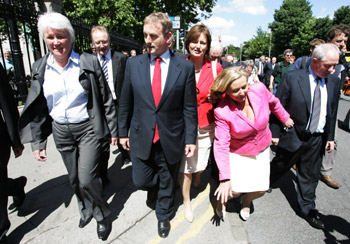Fine Gael stares into the abyss

Despite Fianna Fail’s dismal performance, Fine Gael haven't struck a killer punch. Does this mean its position in Irish politics is practically defunct, asks Dan White
14 July 2010
Last month’s bloody leadership battle leaves Fine Gael staring into the abyss. With some opinion polls showing it falling into second place behind Labour, Fine Gael is now at serious risk of slipping into third place at the next general election.
Oh to have the Australian Labor Party on hand to defenestrate a leader past his sell-by date. Last month the party abruptly replaced its former leader Kevin Rudd with Julia Gillard. This was despite the fact that Rudd had led it to a landslide victory in the 2007 general election after eleven years out of office.
The Fine Gael way
Compare the faultlessly-executed Labor party putsch with the Fine Gael fiasco. The would-be plotters gave Enda Kenny more than four days advance notice of their intention to oust him. This gave Kenny plenty of time to prepare his counter-attack.
While Kenny’s gutsy fight-back will do his public image no harm at all, the fact remains that, after eight years as leader, he has still to close the deal with the Irish public.
Unfortunately for Fine Gael its problems go much deeper than any perceived problems with Kenny’s leadership. Since Fianna Fail was first elected to government in 1932, 78 years ago, Fine Gael has been in power for less than 18 years. During that period it has never been re-elected to consecutive terms in office. By the time of the next election due in June 2012 Fine Gael will have been out of office for twenty-two-and-a-half of the previous twenty-five years.
Before the fall of the Berlin Wall in 1989, while East Germany and several of the other Soviet satellites were in reality one-party states, they were still careful to maintain the illusion of multi-party competition.
Thus at every East German “election” the tame Christian Democrats were guaranteed a quota of seats. Something similar happened in communist-era Poland where the Peasants Party was sure of its 20-odd seats in parliament.
Over the past 78 years, for 60 of which Fianna Fail has been in government, it has been at times difficult not to suspect that Fine Gael were the Irish equivalent of the East German Christian Democrats – a patsy party whose role was to preserve the illusion that Ireland was somehow a multi-party democracy.
Fine Gael’s lackluster response
Further reinforcing doubts about Fine Gael, has been its lacklustre response to the economic catastrophe of the past two years. With its hereditary rival Fianna Fail on the ropes Fine Gael proved unable, at times comically so, to land the killer punch. Instead it has been Eamon Gilmore’s Labour Party which has captured the public yearning for change.
With most of the Fine Gael front bench already dubious about Kenny’s leadership of the party, it was hardly surprising that last month’s Ipsos/MRBI opinion poll in the Irish Times, which showed that Labour had overtaken Fine Gael as the most popular political party, triggered such a dramatic response. Long-simmering doubts about Kenny’s leadership suddenly burst into the open.
Kenny’s success in suppressing the frontbench insurrection hasn’t dispelled these doubts. While the subsequent Red C poll in the Sunday Business Post revealed a modest bounce in support for Fine Gael, Kenny’s own personal ratings remain abysmal. Despite being the nominal leader of the opposition he still trails Gilmore as most voters’ choice for Taoiseach.
So, with a general election due to be held by 2012 at the latest and possibly much sooner, where does this leave Fine Gael?
The first thing to be borne in mind is that, if the evidence of last year’s local and European elections is any guide, both the Ipsos/MRBI and, to a lesser extent, Red C polls understate the true level of Fianna Fail support. On the basis of last year’s results, it still seems reasonable to assume that Fianna Fail will manage to eke out a mid to high-twenties percent first preference vote at the next general election.
While such a result could see Fianna Fail lose up to 30 seats, by far its worst general election since the party was founded in 1926, it still leaves Fianna Fail well-positioned to re-emerge as the dominant political party following the next-but-one election some time around 2017.
Which brings us to the subject of Fine Gael. With Labour surging in urban areas and Kenny’s victory highlighting the fact that Fine Gael’s support base is now predominantly rural, there is now a very real danger that, far from emerging as the largest single party at the next general election, it is overtaken by both Fianna Fail and Labour and slips into third place instead.
Such an outcome would be disastrous for Fine Gael. If third place is the best that it can manage after almost 25 years in continuous opposition and the worst economic downturn in the history of the independent Irish state, then serious questions have to asked about the party’s future.
What does Fine Gael stand for?
What precisely is Fine Gael for? What is the point of a Fianna Fail me-too when the voters have so decisively rejected the original of the species? Is the Fine Gael the political equivalent of a bed-blocker, obstructing the sort of change our broken political system so badly needs?
Up to recently most observers would have confidently predicted that it would be Fianna Fail which ended up paying the price for the Celtic Tiger bust. Not any longer. Don’t be surprised if it is Fine Gael rather than its larger rival that ends up being the main casualty instead.



 Print
Print






Fans 0
Followers